List of pastries

The following is a list of pastries, which are small buns made using a stiff dough enriched with fat. Some dishes, such as pies, are made of a pastry casing that covers or completely contains a filling of various sweet or savory ingredients.
There are five basic types of pastry dough (a food that combines
Pastries were first created by the
Pastries
| Name | Image | Origin | Description |
|---|---|---|---|
| Alexandertorte | 
|
Latvia | Pastry strips filled with berries.[2][3] |
| Alfajor | 
|
Argentina | Pastry strips filled with dulce de leche. |
| Apple strudel | 
|
Central Europe | Sliced apples and other fruit are wrapped and cooked in layers of filo pastry. The earliest known recipe is in Vienna, but several countries in central and eastern Europe claim this dish.[4] |
| Bahulu | 
|
Malaysia | A Malay pastry similar like the eggs, sugar and baking powder. Usually served during the religious celebration in the country.[6][7]
|
| Bakewell pudding | 
|
United Kingdom (England) | First created by accident in Bakewell around 1860, this has a flaky pastry base covered with raspberry jam and topped with custard and almonds. The Bakewell tart is similar but tends to use shortcrust pastry with a layer of sponge instead of custard.[8] |
| Baklava | 
|
Ottoman Empire | An Ottoman pastry that is rich and sweet, made of layers of filo pastry filled with chopped nuts and sweetened with syrup or honey.[9] |
Bakpia Pathok
|

|
Indonesia (Yogyakarta) | Small, round-shaped Chinese-Indonesian pastries, usually stuffed with mung bean paste. |
| Banitsa | 
|
Bulgaria | Prepared by layering a mixture of whisked eggs and pieces of cheese between filo pastry, which is then baked in an oven
|
Banket
|

|
Netherlands | Popular during the Christmas season, prepared by rolling pastry dough around an almond paste filling and then baking it. The log is then cut into short lengths for serving, hot or cold.
|
| Bear claw | 
|
United States | Sweet breakfast pastry. |
Beaver Tail
|

|
Canada | A fried dough pastry, individually hand stretched to resemble a beaver's tail then covered in different toppings including cinnamon and sugar, fruit jams, chocolate, peanut butter, butter and garlic, and M&Ms. In some parts of Canada, it is also called an "Elephant Ear". |
| Bedfordshire clanger | 
|
United Kingdom (England) | From Bedfordshire and surrounding counties in the east of England. An elongated suet crust dumpling, traditionally boiled, now often baked. Containing a savoury filling at one end (usually gammon) and a sweet filling at the other (typically apple). |
| Belekoy | 
|
Philippines
(Bulacan) |
Made with sesame seeds and vanilla .
|
| Belokranjska povitica | Slovenia | National dish that consists of a pastry roll with fillings. (English: White country (or white mountain) rolled cake). | |
Berliner
|

|
Germany/Central Europe | A Berliner Pfannkuchen is a traditional North German-Central European pastry similar to a doughnut with no central hole made from sweet yeast dough fried in fat or oil, with a marmalade or jam filling and usually icing, powdered sugar or conventional sugar on top. |
| Bethmännchen | 
|
Germany | A sweet from egg . Typically prepared for Christmas.
|
| Bibingka | 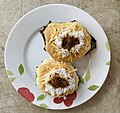
|
Philippines | A type of rice cake baked in clay pot. Often with toppings of butter, salted duck egg, muscovado sugar, grated cheese and desiccated coconut. |
| Bichon au citron | 
|
France | Similar to a lemon curd . The outer layer of sugar is sometimes partially caramelized.
|
| Bierock | 
|
Russia | Savory pocket pastries originating in Volga German community in the United States and Argentina. It was brought to the United States in the 1880s by German Russian Mennonite immigrants.[10]
|
| Birnbrot | 
|
Switzerland | A traditional pastry originating in Switzerland with a filling of dried pears |
| Bizcocho | 
|
Spain, Latin America | The name given in Spain and several Latin American countries to many variants of buttery flaky pastry and some cookies |
| Börek | 
|
Balkans, Middle East, Central Asia | A family of pastries or pies found in the Balkans, Middle East, and Central Asia. The pastry is made of a thin flaky dough such as filo with a variety of fillings, such as meat, cheese, spinach, or potatoes. |
| Bossche bol | 
|
Netherlands | Sometimes called chocoladebol ("chocolate ball") in its city of origin, is a pastry from the Dutch city of 's-Hertogenbosch (also called Den Bosch). It is effectively a large profiterole, about 12 centimetres (4.7 in) in diameter, filled with whipped cream and coated entirely or almost entirely with (usually dark) chocolate. |
| Bougatsa | 
|
Greece | A Greek breakfast pastry consisting of semolina, custard, feta or minced meat filling between layers of filo. When with semolina or custard filling is considered a sweet dessert and is topped with icing sugar and cinnamon powder. |
| Boyoz | 
|
Turkey (İzmir) | A Turkish pastry of millefeuille . The small balls can then be put on a tray into a very high-temperature oven either in plain form or with fillings of cheese or spinach added inside.
|
| Bridie | 
|
United Kingdom (Scotland) | a Scottish meat pastry that originates from Forfar, Scotland. Bridies are said "to have been 'invented' by a Forfar baker in the 1850s".[11] The name may refer to the pie's frequent presence on wedding menus, or to Margaret Bridie of Glamis, "who sold them at the Buttermarket in Forfar."[12] They are similar to pasties, but because they are made without potatoes, are much lighter in texture. |
| Briouat | 
|
Morocco | A sweet puff pastry and part of Moroccan cuisine |
| Bruttiboni | 
|
Italy (Prato, central Italy) | Almond-flavored biscuit |
| Bundevara | 
|
Serbia | A pie filled with pumpkin, and could refer to either a savijača (made of rolled filo) or a štrudla (made of rolled dough). Both sweet and salty pies are made. |
| Butterkaka | 
|
Sweden | Similar to cinnamon rolls, but baked together in a cake pan like sticky buns. |
| Canelé | 
|
France (Bordeaux) | A small pastry with a soft and tender custard center and a dark, thick caramelized crust, classically created by brushing the mould with melted beeswax. |
| Cannoli siciliani | 
|
Italy (Sicily) | Cannoli consist of tube-shaped shells of fried pastry dough, filled with a sweet, creamy filling usually containing ricotta. They range in size from "cannulicchi", no bigger than a finger, to the fist-sized proportions typically found in Piana degli Albanesi, south of Palermo, Sicily. |
| Carac | 
|
Switzerland (French) | A Swiss pastry made of chocolate, usually found in the French part of Switzerland. |
ChaSan
|
China (Huai'an) | A traditional , and especially in Huai'an, a historic city which is considered as the home of Chasan. | |
Chatti Pathiri
|

|
India (Kerala) | A layered pastry made in the Kerala State. It is made in both sweet and savory variations. The dish is very similar to the Italian lasagna . Instead of pasta; pastry sheets or pancakes made with flour, egg, oil and water are used.
|
| Cheesymite Scroll | 
|
Australia | A spiral pastry similar to Pain aux raisins, but is savory with cheese and Vegemite as the filling. These are most commonly found at the Australian bakery chains Bakers Delight and Brumby's Bakeries, but is also a popular home-made dish served - depending on the size of the scroll - as lunch or as a snack. |
Chouquette
|

|
France | chocolate chips .
|
| Choux à la crème | 
|
France | A light raising agent it employs high moisture content to create steam during cooking to puff the pastry.
|
Cinnamon Bun
|

|
Sweden | A cinnamon roll consists of a rolled sheet of yeast-leavened dough onto which a cinnamon and sugar mixture (and raisins or other ingredients in some cases) is sprinkled over a thin coat of butter. The deep fried version is cinnamon roll or cinnamon bun doughnut. Its main ingredients are flour, cinnamon, sugar, and butter, which provide a robust and sweet flavor. |
| Coca | 
|
Spain | Typically made and consumed in territories of Catalan culture.[13][14][15][16] There are many diverse cocas, with four main varieties: sweet, savory, closed and open. |
| Conejito | 
|
Chile | Similar to berliner but baked in the oven, not fried. |
Cornish pasty
|

|
United Kingdom (England) | Sometimes known as a "pastie" or "British pasty" in the United States,[17] is a filled pastry case, associated in particular with Cornwall in south west England. It is made by placing the uncooked beef & potatoes, onions, swede filling on a flat pastry circle, and folding it to wrap the filling, crimping the edge at the side or top to form a seal. The result is a raised semicircular end-product. |
| Concave cake | 
|
Taiwan | A traditional Taiwanese cake commonly made using eggs, egg yolk, low-gluten flour, honey and a small portion of sugar. The cake filling leaks out when sliced, similar in appearance to a volcano. |
Conversation
|
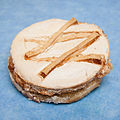
|
France | A patisserie developed in the late 18th century that is made with puff pastry, filled with a frangipane cream, and topped with royal icing.[18] |
| Cornulețe | 
|
Romania, Moldova | A pastry aromatised with vanilla or rum extract/essence, as well as lemon rind, and stuffed with Turkish delight, jam, chocolate, cinnamon sugar, walnuts, and/or raisins. |
| Coussin de Lyon | 
|
France (Lyon) | A sweet specialty of Lyon composed of chocolate and curacao .
|
| Cream horn | 
|
A pastry made with jam and whipped cream. The horn shape is made by winding overlapping pastry strips around a conical mold. After baking, a spoonful of jam or fruit is added and the pastry is then filled with whipped cream. The pastry can also be moistened and sprinkled with sugar before baking for a sweeter, crisp finish.[19]
| |
| Crêpes Suzette | 
|
France | a Curaçao liqueur. It is often served “flambé .”
|
Crocetta of Caltanissetta
|

|
Italy (Sicily,Caltanissetta) | Sweet disappeared and rediscovered in 2014. The ingredients of the crocetta ("small cross") are typical of the area of , and powdered sugar. The crocetta is produced in two variants: lemon flavored and covered in powdered sugar, or orange flavored and topped with ground pistachio. |
| Croissant | 
|
France | A Kipferl – ancestor of the croissant – has been documented in Austria going back at least as far as the 13th century, in various shapes.[20] The Kipferl can be made plain or with nut or other fillings (some consider the rugelach a form of Kipferl). The "birth" of the croissant itself – that is, its adaptation from the plainer form of Kipferl, before its subsequent evolution (to a puff pastry) – can be dated with some precision to at latest 1839 (some say 1838), when an Austrian artillery officer, August Zang, founded a Viennese Bakery ("Boulangerie Viennoise") at 92, rue de Richelieu in Paris.[21] This bakery, which served Viennese specialities including the Kipferl and the Vienna loaf, quickly became popular and inspired French imitators (and the concept, if not the term, viennoiserie , a 20th-century term for supposedly Vienna-style pastries). The French version of the Kipferl was named for its crescent (croissant) shape.
|
| Croline | A flaky (typically puff) pastry filled with various (traditionally) salty or spicy fillings. Normally the top side of the pastry is latticed. Both sweet and savory croline varieties exist. | ||
| Cronut | 
|
United States | A croissant-doughnut pastry attributed to New York City. |
| Croquembouche | 
|
France | A traditional dessert in It is traditionally served during wedding reception. |
| Curry puff | 
|
Southeast Asia | A Southeast Asian snack. It is a small pie consisting of specialised curry with chicken and potatoes in a deep-fried or baked[24] pastry shell, and it looks like the Portuguese stuffed bread called Empanada. The curry is quite thick to prevent it from oozing out of the snack. |
| Dabby-Doughs | 
|
Traditionally made using the remnants of the dough leftovers from making the pie, they can also be prepared in large amounts by simply making a batch of pastry dough. The filling of a dabby-dough typically consists of a mixture of cinnamon and white sugar sprinkled on butter or margarine, rolled, sliced and baked. | |
| Danish pastry | 
|
Denmark | A sweet pastry, of Viennese origin, which has become a speciality of Denmark and neighboring Scandinavian countries. Called 'facturas' in Argentina and neighbouring countries (of which 'tortitas negras' are a type). Pictured is a pecan and maple Danish pastry |
Djevrek
|

|
Ottoman Empire | A ring-shaped bread-pastry covered with . |
| Dutch letter | 
|
Netherlands | Typically prepared using flour, eggs and butter or puff pastry as its base and filled with almond paste, dusted with sugar and shaped in an "S" or other letter shape. It was introduced into the United States by Dutch immigrants in the mid 19th century. |
Éclair
|

|
France (likely) | An oblong pastry cream (crème pâtissière), custard, whipped cream, or chiboust cream; and iced with fondant icing.[26] The éclair probably originated in France during the nineteenth century.
|
| Egg yolk pastry | 
|
Taiwan | A traditional Taiwanese mooncake, in which the filling is made of salted duck egg yolk and red bean paste. Egg yolk pastries use naturally fermented salted egg yolks marinated in red soil with grape seed oil, and they are made with many layers. |
| Empanada | 
|
Spain | A stuffed bread or pastry baked or fried in many countries in |
| Ensaïmada | 
|
Spain(Balearic Islands) | A common cuisine eaten in most former Spanish territories in mother dough and a kind of reduced pork lard named saïm. In Ibiza there is a sweet called greixonera made with ensaimada pieces left over from the day before.[33]
|
| Fa gao | 
|
China | A fermentation (such as overnight) prior to being steam-cooked. Commonly consumed on the Chinese New Year .
|
| Fazuelos, Fijuelas, or Deblas | 
|
Sephardic )
|
A fried thin dough made of flour and a large number of eggs. A traditional Moroccan Jews eat them with cinnamon and syrup.
|
| Fig roll | 
|
Egypt (Ancient)[citation needed] | An ancient Fig Newton
|
| Flaky pastry | 
|
In baking, a flaky pastry (also known as a "quick puff pastry" or "blitz puff pastry")[34] is a light, flaky, unleavened pastry, similar to a puff pastry. The main difference is that in a flaky pastry, large lumps of shortening (approximately 1-in./2½ cm. across), are mixed into the dough, as opposed to a large rectangle of shortening with a puff pastry. | |
| Flaugnarde | 
|
France | a baked French dessert with fruit or nuts arranged in a buttered dish and covered with a thick flan-like batter. |
Flaons
|

|
Spain | Flaons have different shapes, and fillings usually consist of some type of cheese, varying according to the location. Sweet flaons are usually sweetened with sugar, but honey was traditionally used more often. Historically the first recorded mention of these cakes is from 1252 and they are mentioned as well in Ramon Llull's book Blanquerna, written in 1283.[citation needed] |
Flies graveyard
|

|
United Kingdom (England) | "Flies Graveyard" or "Flies Cemetery" are nicknames used in various counties of England for sweet pastries filled with currants or raisins, which are the "flies" in the "graveyard" or "cemetery". The mixture is similar to sweet mince pies. |
| Franzbrötchen | 
|
Germany (northern) | Commonly found in northern Germany, especially Hamburg, Franzbrötchen is a small, sweet pastry, baked with butter and cinnamon. Sometimes other ingredients are used, such as chocolate or raisins. |
| Galette | 
|
France | Galette is a term used in cakes . One of the most known is the "galette des rois".
|
| Gâteau Basque | 
|
Basque region)
|
Gâteau Basque is typically constructed from layers of an pastry cream or preserved cherries.
|
| Şorqoğal | 
|
Azerbaijan | Şor qoğal is traditional food from Azerbaijan which consist of dough thin layers with different flavors and butter between the layers. |
| Gibanica | 
|
Balkans | A traditional Serbian pastry dish, usually made with white cheese, now popular throughout the Balkans. Recipes can range from sweet to savory, and from very simple to festive and elaborate multi-layered cakes. |
Gujiya
|

|
India | A traditional Indian pastry, typically prepared by filling a round, flat pastry with a sweet filling made of dried fruits, grated coconut and condensed milk solids. It is usually fried in ghee, and sometimes soaked in sugar syrup. It is popular in the northern part of India during the festival of Holi. |
| Gözleme | 
|
Turkey | A savory traditional Turkish handmade and hand-rolled pastry. Fresh pastry is rolled out, filled and sealed, then cooked over a griddle. Fillings include spinach, beyaz peynir, minced meat, egg and other foodstuffs. |
| Gundain | Tibet | A pastry in Tibetan New Year and Losar as a starter.
| |
| Gustavus Adolphus pastry | 
|
Sweden | Pastry named for King Gustavus Adolphus of Sweden, eaten every year on his memorial day, Gustavus Adolphus Day , 6 November. There are different recipes, but what they all have in common is a portrait of the king on top, made in chocolate or marzipan.
|
Gyeongju bread
|

|
Hwanghae )
|
Gyeongju bread is a common name for what's also called "Hwangnam bread". The pastry is named after Hwanghae Province, the province of its origin, which was divided into the North and South Hwanghae Provinces in 1954. A local specialty of Gyeongju City, South Korea. A small pastry with a filling of red bean paste. Gyeongju bread was first baked in 1939 at a bakery in Hwangnam-dong in central Gyeongju. It has since become popular across the country and is produced by several different companies, all based in Gyeongju. |
| Haddekuche | 
|
Germany (Frankfurt, Hesse) | A traditional pastry made in Frankfurt, Hesse, Germany, it is typically a diamond-shaped gingerbread. The word Haddekuche means "hard cake". This is because it tends to dry relatively quickly and then become very hard. |
| Hamantash | 
|
Ashkenazi )
|
A filled-pocket cookie or pastry in Their formation varies from hard pastry to soft doughy casings. |
| Hellimli | Cyprus | A Cypriot savory pastry made with Halloumi cheese. | |
| Heong Peng | 
|
Malaysia | Heong Peng resemble slightly flattened balls, contain a sweet sticky filling made from malt and shallots, which is covered by a flaky baked crust and garnished with sesame seeds on the surface. Popular with the Malaysian Chinese community, especially those in Northern Peninsular Malaysia. |
| Hot Cross Bun | United Kingdom | A hot cross bun is a traditional baked treat, typically made from a soft, spiced dough enriched with raisins or currants. It's known for its distinctive cross-shaped marking on top, often made of icing or a simple flour paste. Hot cross buns are commonly enjoyed as a seasonal delicacy during the Easter period, symbolizing the crucifixion of Jesus Christ on Good Friday. They are usually served toasted and buttered, making for a deliciously comforting snack or breakfast item. | |
| Hot water crust pastry | 
|
United Kingdom (England) | Hot water crust is a type of pastry used for savory pies, such as pork pies, game pies and, more rarely, steak and kidney pies. Hot water crust is traditionally used for making hand-raised pies. The pastry is made by heating water, melting the fat in this, bringing to the boil, and finally mixing with the flour. When baked, the crust acquires a rich, shiny, golden-brown exterior, which is fairly crisp and water-resistant. This allows the pies to be filled with a savoury jelly or gravy as they cool, often through a central hole in the crust made expressly for the purpose during raising. |
| Huff paste | United Kingdom (England) | Huff paste was a cooking technique that involved making a stiff pie shell] | |
| Inipit | 
|
Philippines | Inipit is a flat pastry made of flour, milk, Guiguinto, Bulacan is known for its inipit.
|
| Jachnun | 
|
Jewish (Yemen )
|
A traditional skhug .
|
| Jalebi | 
|
India, Pakistan | A sweet popular in rosewater or other flavours such as kewra water.
|
| Jambon | 
|
Ireland | Square pastries filled with cheese and chunks of ham.[42] |
Jesuite
|

|
France | A triangular, flake pastry filled with Jesuit’s hat.[43]
|
| Ji dan gao | 
|
Taiwan | Taiwanese sponge cakes served as desserts. They are prepared by steaming sponge cakes made of rice flour, milk, eggs and sugar. |
Joulutorttu
|

|
Finland | A Christmas pastry that is traditionally made from puff pastry in the shape of a star or pinwheel and filled with prune jam and often dusted with icing sugar. |
Kalács
|

|
Hungary | A ). |
Kanafeh
|

|
Middle East | A Middle Eastern sweet made of very fine qata'if, is recorded in medieval Arab cookbooks from various regions.[45] It has also been a staple of the cuisines of the former Ottoman Empire in the Eastern Mediterranean. Several variations of the dish exist.
|
| Karakudamono | 
|
Japan | A Japanese term used to collectively describe assorted pastry confections of Chinese origin (also called togashi) that were introduced to Japan through the efforts of an envoy to Tang China. |
| Kifli | 
|
Slovakia, Hungary | Diós kifli, mákos kifli, also known as Pozsonyi kifli are crescent shaped sweet leavened pastries filled with a sweet flavored confectioners' sugar before allowed to cool. |
Klobasnek
|

|
Czech | A savory finger food of kolache (koláče); however, most Czechs hold the distinction that kolache are only filled with non-meat fillings. Klobasniky are similar in style to a pigs in a blanket or sausage roll , but wrapped in kolache dough.
|
| Knieküchle | 
|
Germany | A traditional German fried dough pastry that is very popular in confectioner's sugar. In Austria it is eaten with apricot marmalade. According to legend the name derives from the practice of baker women from Franconia that stretched the dough over their knees very thinly so they could read love letters through it.[citation needed ]
|
| Knish | 
|
Eastern Europe | An sweet potatoes, black beans, fruit, broccoli, tofu, or spinach. Knishes may be round, rectangular, or square. They may be entirely covered in dough or some of the filling may peek out of the top. Sizes range from those that can be eaten in a single bite hors d'oeuvre to sandwich -sized.
|
Kolache
|
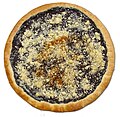
|
Central Europe | Holds a dollop of fruit rimmed by a puffy pillow of supple dough. kołacz. The word kolache itself means 'a small cookie' in Macedonian .
|
| Kolompeh | 
|
Iran | Kolompeh looks like a walnuts and cooking oil are the main ingredients.[51]
|
Kołacz
|

|
Poland | A traditional Slavic pastry have found entrance into many Central and Eastern European cuisines.
|
| Komaj sehen | 
|
Kerman Province )
|
Prepared with dates and various nuts |
| Kouign-amann | 
|
France (Brittany) | A Breton cake containing layers of butter and sugar folded in, similar in fashion to puff pastry albeit with fewer layers. The sugar caramelizes during baking. The name derives from the Breton words for cake (kouign) and butter (amann).
|
Krempita
|

|
Balkans | A well-known dessert from the former Yugoslavia . The dish is usually prepared with puff pastry dough.
|
| Kringle | 
|
Scandinavia | A Scandinavian pastry, a Nordic variety of pretzel, which arrived with Roman Catholic monks in the 13th century, especially in Denmark. It developed further into several kinds of sweet, salty or filled pastries. The word originates from the Old Norse kringla, meaning ring or circle. |
| Kroštule | 
|
Croatia | A traditional pastry from Dalmatia and Istria, made by deep frying the prepared dough. |
| Kūčiukai | 
|
Lithuania | A traditional Lithuanian pastry served on Kūčios, the traditional Christmas Eve dinner in Lithuania. They are small slightly sweet pastries made from leavened dough and poppy seeds. There are variations in sweetness, and though usually served soaked in poppy seed milk, they are also eaten without it. |
| Kürtőskalács | 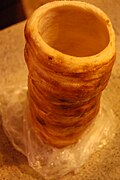
|
Transylvania | Also known as "chimney cake", "stove cake", or "Hungarian wedding cake", baked on a tapered cylindrical spit over an open fire. Kürtőskalács originated from Transylvania. caramelized on the kürtöskalács surface, creating a sweet, crisp crust.
|
Ladies' navels
|

|
Turkey | Ladies' navels (kadın göbeği) are balls of choux pastry which are given a dimple, deep-fried and then soaked in syrup. Other Turkish pastries have sensuous names such as girls' breasts (kız memesi) and lips of the beauty (dilber dudağı).[53][54] |
| Lattice | 
|
A pastry used in a criss-crossing pattern of strips in the preparation of various foods. Latticed pastry is used as a type of lid on many various tarts and pies. The openings between the lattice allows fruit juices in pie fillings to evaporate during the cooking process, which can caramelize the filling.[55] Pictured is a strawberry-rhubarb pie with lattice pastry. | |
| Leipziger Lerche | 
|
Germany | A pastry of Leipzig, Germany, the name originates from the singing bird lark (German:Lerche), which was roasted with herbs and eggs or served as a filling in pastries. In the year 1720 alone, 400,000 larks were sold in Leipzig as a delicacy.[56] A typical version consists of a shortcrust filled with a mixture of crushed almonds, nuts and a cherry. The cherry symbolises the heart of the bird. It is topped with a grid of two crossed dough strips. The term Leipziger Lerche has been protected by the saxonian bakery guild since 2004.[citation needed] |
| Lek-tau-phong | 
|
Taiwan | A traditional Taiwanese mooncake, in which the filling is made of sweet mung bean paste stuffed with lard and shallots and baked, and sometimes a little pork is added. |
| Linzer torte | 
|
Austria | A plum butter, thick raspberry,[58] or apricot jam.
|
| Lotus seed bun | 
|
China | A Chinese pastry prepared by steaming a yeast-based dough and contain a lotus seed filling.[59] It can be classified as a dim sum , though not exclusively so.
|
| Ma'amoul | 
|
Middle East | Ma'amoul are small figs, or other fillings). They are popular in Levantine cuisine and in the Persian Gulf countries. They may be in the shape of balls or of domed or flattened cookies.
|
| Macaron | 
|
France | They have a debated origin, but the earliest form of modern macaron was likely baked in almond flour and confectioners' sugar which is folded into a meringue of stiffly beaten egg whites. This mixture is tinted with food coloring and baked into disks, which are sandwiched with buttercream, ganache, or curd . Known for its smooth skin, ruffled feet, and delicate texture.
|
Makmur
|
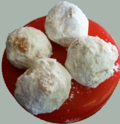
|
Malaysia, Singapore and Brunei | Traditional |
| Makroudh | 
|
North Africa | A pastry of Tunisian origin eaten in almonds.[62]
|
| Malsouka | 
|
North Africa | A Tunisian pastry.[63] Sheets of malsouqa are usually sold in stacks wrapped in cellophane. Malsouqa are used to make samosa and brik (a Tunisian savory pastry), in addition to dishes with a variety of other fillings. |
| Mandelkubb | 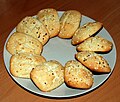
|
Sweden | A baker's ammonia .
|
Mantecadas
|

|
Spain | Maragateria comarca. They taste very much like pound cake . Pictured are commercial mantecadas.
|
| Marillenknödel | 
|
Central Europe | A pastry found in the traditional Topfenteig " (quark cheese).
|
| Masan | Tibet | A pastry in Tibetan cuisine made with tsampa, dry cubic or curd cheese, yak butter, brown sugar and water.[64] | |
| Miguelitos | 
|
Castile-La Mancha )
|
Pastry-cake prepared from soft puff pastry, filled with a creamy custard and covered with powdered sugar. |
Milhoja
|

|
Argentina | A dessert made with stacked layers of puff pastry[65] filled with dulce de leche; a creamy mix of condensed milk, sugar, and vanilla; or sometimes white chocolate. In Argentina it's filled with Dulce de leche and topped with Italian merengue |
| Milk-cream strudel | 
|
Central Europe | A traditional Viennese Austro-Hungarian empire (1867–1918). The milk-cream strudel is an oven-baked pastry dough stuffed with a sweet bread, raisin and cream filling and served in the pan with hot vanilla sauce.[66]
|
| Mille-feuille | 
|
France | The mille-feuille ("thousand sheets"), vanilla slice, cream slice, custard slice, also known as the Napoleon or kremschnitt, is a confectioner's sugar, and sometimes cocoa, or pulverized nuts (e.g. roasted almonds). Alternatively the top is glazed with icing or fondant in alternating white (icing) and brown (chocolate) stripes, and combed .
|
| Moorkop | 
|
Netherlands | Consists of a profiterole (cream puff) filled with whipped cream. The top of the profiterole is glazed with white or dark chocolate. Often there is whipped cream on the top, with a slice of tangerine or a piece of pineapple. |
| Muskazine | 
|
Austria | A rich jam . It is traditionally eaten at Christmas time, often accompanying a glass of sweet dessert wine.
|
| Naiyou subing | 
|
Taiwan | A Taiwanese buttery flaky pastry made into a thin circle. The dough has many layers, of which each is very thin and crisp. The filling is composed of butter and maltose. |
| Nazook | 
|
Armenia | Also spelled nazouk or nazuk, it is a crisp, but soft, and buttery, sweet, but not too sweet, pastry made with flour, butter, sugar, sour cream, yeast, vanilla extract and eggs for the wash. After the dough is made, it is refrigerated, then rolled out flat, covered in a spread made of flour, sugar, vanilla and butter, kind of like a streusel topping, rolled up into a long skinny loaf shape. The strip is washed with egg wash, cut into sections and then baked. |
| New York roll | 
|
United States | Originally called the Sûpreme, the pastry consists of croissant dough rolled and filled with pastry cream and dipped in ganache. |
| Nun's puffs | 
|
France | Made from butter, milk, flour, sugar, eggs and sometimes honey, |
| Nunt | Jewish
|
A pastry originating from Jewish cuisine and vaguely resembles nougat. The pastry is predominantly served at the Jewish celebration of Purim, where self-made sweets are customarily given to neighbours and friends. Nunt is traditionally made from dark forest honey, which is cooked along with sugar and then mixed with coarsely cut walnuts. The result is placed on a smooth, wet board or an oiled marble plate, left to cool, and then cut into small rhombic-shaped pieces. | |
Öçpoçmaq
|

|
Tatar )
|
Sometimes known as treugolnik (треугольник) among the . |
| Ox-tongue pastry | 
|
China | A Chinese . The pastry texture is chewy, with a soft interior and a crunchy crust. |
| Pa de pessic, bescuit, pa d'En Pou |  |
Catalan Countries | Pa de pessic, bescuit (as it is called in the Valencian Community and other places) or pa d'En Pou (as it is called in Mallorca) is a type of thin, light and spongy dough cake, made of flour, eggs, sugar and frequently yeast. Many times it is perfumed with lemon or orange zest, and sometimes with a little cinnamon or some liquor. The basic cake that only contains eggs, sugar and flour is often called Genovese (for every 100g of flour it contains 4 eggs and 100g of sugar) and is the basis of many filled cakes. |
| Pain au chocolat | 
|
France | "Chocolate bread", also called a chocolatine in southern French Canada, is a French pastry consisting of a cuboid-shaped piece of yeast-leavened laminated dough, similar to puff pastry, with one or two pieces of chocolate in the centre.
|
| Pain aux raisins | 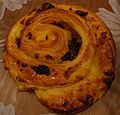
|
France | Typically a variant on the crème pâtissière filling. Known in Australia as an "escargot", a member of the pâtisserie viennoise family of baked foods.
|
| Palmier | 
|
France, French Algeria | A "palm tree" ( German, Spanish, French, Italian, Jewish, and Portuguese pastry (among other cuisines, like those of the former Spanish colonies in the Americas) formed in a palm or butterfly shape. Made using puff pastry , sugar and sometimes honey.
|
Pannekoek
|

|
United States by German Americans | A style of Scotch pancake counterparts, but not as thin as Crêpes .
|
Pan dulce
|

|
Latin America | (literally "sweet bread"), pan dulce is one of a common treat in Mexico and other Latin American countries. |
Panzarotti
|

|
Italy (central and southern) | Filled, savory pastries, different forms of which are popular in Italy, as well as among Italian immigrants to Canada and the United States. Panzerotti originated in central and southern Italy, especially in Apulia. They are small versions of the calzone or closed pizza, but produced with a softer dough. The most common fillings are tomato and mozzarella, but spinach, mushrooms, baby corn, and ham are often used. The dish has many variations. |
| Papanași | 
|
Romania, Moldova | A morello jam. Pictured is Papanași with sour cherries (morello) and powdered sugar.
|
| Paper wrapped cake | 
|
Hong Kong | Chinese pastry, one of the most standard pastries served in Hong Kong. It can also be found in most Chinatown bakery shops overseas. In essence, it is a chiffon cake baked in a paper cup.
|
| Paris–Brest | 
|
France | Made of choux pastry and a praline flavoured cream. It was created in 1891 to commemorate the Paris–Brest–Paris bicycle race.[70] Its circular shape is representative of a wheel. It became popular with riders on the Paris–Brest cycle race, partly because of its energy-giving high calorific value, and is now found in pâtisseries all over France [1]. |
| Paste | 
|
Mexico | Small pastry produced in central Mexico. Unlike empanadas, the filling ingredients for pastes are not cooked before they are wrapped in the pastry casing. Pastes use a firm and thin layer of dough. |
| Pastel | 
|
Latin America | A name given to different typical dishes of many countries with Iberian heritage. For example, in Brazil, a pastel is a common fast food dish, consisting of thin pastry envelopes wrapped around assorted fillings, then deep fried in vegetable oil. Pictured is a Brazilian pastel. |
| Pastizz | 
|
Malta | A savory pastry from Malta, pastizzi usually have a filling either of ricotta or of mushy peas, and are called pastizzi tal-irkotta, "cheesecakes", or pastizzi tal-piżelli, "peacakes", accordingly.[71][72] Pastizzi are a popular and well-known Maltese food. Pictured are two varieties of Maltese pastizzi. |
| Pastry heart | 
|
United States (Buffalo, New York area) | A regional dessert item found in the Buffalo, New York area.[73][74] The pastry heart is a heart shaped flaky puff pastry, similar to a palmier or palm leaves pastry, that is usually topped with a white sugar icing that has a hard shell but is soft on the inside.[73][75] |
Pâté Chaud
|

|
Vietnam | A puff pastry in Vietnamese cuisine, its name means "hot pie" in French. The pastry is made of a light layered and flaky exterior with a meat filling. Traditionally, the filling consists of a pork meat, but today, chicken and beef are commonly used. |
Phyllo
|
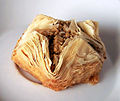
|
Middle East, Balkans | Paper-thin sheets of pastries. filo is often used in Middle Eastern and Balkan cuisine. Pictured is Baklava made with the dough. An early, thick form of filo appears to be of Central Asian Turkic origin.[76][77] May also be spelt as "Filo pastry"; this is quite a common spelling for this form of pastry in the United Kingdom .
|
| Pineapple cake | 
|
Taiwan | A Taiwanese sweet traditional pastry and dessert containing butter, flour, egg, sugar, and pineapple jam or slices. |
| Pionono | 
|
Hispanic | May refer to several varieties of pastry popular in Spain, Latin America and The Philippines. Pictured are pionono in Málaga, Spain. |
| Pithivier | 
|
France (probably Pithiviers) | (Pithiviers in French) is a round, enclosed confectioner's sugar at the end of baking, or both. Whilst the filling of the Pithivier is often a sweet frangipane of almond paste (optionally combined with fruit such as cherry or plum), savory pies with a meat or cheese filling can also be termed as a Pithivier.
|
| Plăcintă | 
|
Romania, Moldova, Ukraine | Plăcintă Urdă or apples. Also made with pumpkin filling, they were brought to the US by the Black Sea Germans who had lived in the territories of the southern Russian Empire (modern-day Ukraine and Moldova).
|
| Poffertjes (Dutch) Æbleskiver (Danish) | 
|
Northern Europe | A style of Scotch pancake or as French Crêpes. They can be leavened by yeast, egg white, or a chemical agent like baking powder .
|
| Pogača | 
|
Balkans | appetizer instead of bread. Hot pogača filled with sour cream (or beyaz peynir in Turkey and Bulgaria) is considered a particularly delicious specialty.
|
| Poppy seed roll | 
|
Central Europe | Roll of sweet yeast bread (a viennoiserie) with a dense, rich, bittersweet filling of poppy seed. A popular cuisine in parts of Central Europe, Eastern Europe and in Israel. An alternative filling is a paste of minced walnuts, making it a walnut roll. |
| Pot pie | 
|
United States, Canada | In US and Canadian dialects, is a type of meat pie with a top pie crust that is commonly used throughout the continent, consisting of flaky pastry. Pot pies may be made with a variety of fillings including poultry, beef, seafood, or plant-based meat substitute fillings, and may also differ in the types of crust. Chicken pot pie is the most popular variety of the dish. |
| Prekmurska gibanica | 
|
Slovenia | Gibanica or layered cake that includes a thinly-rolled pastry dough in its preparation. It originated in the region of Prekmurje, Slovenia.[79] It contains poppy seeds, walnuts, apples, raisins, and ricotta fillings. Although native to Prekmurje, it has achieved the status of a national speciality of Slovenia. It is also popular in northern Croatia. |
| Profiterole | 
|
France | Known as a "cream puff" in the United States, a profiterole is a filled with whipped cream, pastry cream, or ice cream. This treat is typically very sweet. The puffs may be decorated or left plain or garnished with chocolate sauce, caramel, or a dusting of powdered sugar .
|
| Puff pastry | 
|
Europe | In baking, a puff pastry is a light, flaky, leavened pastry containing several layers of fat which is in solid state at 20 °C (68 °F). In raw form, puff pastry is a dough which is spread with solid fat and repeatedly folded and rolled out (never mashed, as this will destroy layering) and used to produce various pastries. It is sometimes called a "water dough" or détrempe. |
| Puits d'amour | 
|
France | A confectioners' sugar or covered with caramel . The name has erotic connotations; it literally translates into English as 'wells of love.’
|
| Punsch-roll | 
|
Sweden | A Swedish, small cylindrical pastry covered with green marzipan with the ends dipped in chocolate, with an interior consisting of a mix of crushed cookies, butter, and cacao, flavoured with punsch liqueur. The Dutch variant is called mergpijpje, and is cream-colored instead of green. Often called dammsugare ("vacuum cleaner"), referring not only to its appearance, but also to the supposed practice of the pastry baker collecting crumbs from the day's cookies for filling.[citation needed] Other names are arraksrulle (as arrak is an ingredient in punsch) and "150-ohmer" (due to the brown-green-brown coloring).[citation needed] In Denmark, these treats are known as Træstammer ("wooden logs"); the interior cacao-paste is flavoured with rum and the marzipan is usually not coloured. |
| Punschkrapfen | 
|
Austria | Translated in English as "punch cake", a classical confection of pastry with a rum flavor. It is similar to the French pastry, the petit four. Commonly available in pastry shops and bakeries in Austria. It is a cake filled with cake crumbs, nougat chocolate, apricot jam and then soaked with rum. |
| Qottab | 
|
Iran | An almond-filled deep-fried Persian cake,[80] prepared with flour, almonds, powdered sugar, vegetable oil, and cardamom. The city of Yazd is well known for its qottab.
|
| Quesito | 
|
United States (Puerto Rico) |
A cheese-filled pastry twist from Puerto Rico.[81] The cheese is usually whipped with vanilla, eggs, and sugar. The cheese can also be whipped with guava, papaya and other tropical fruit preserves. The mixture is stuffed into a dough that resembles puff pastry, coated in a sugary caramelized syrup, and baked. |
| Roti john | 
|
Malaysia | A type of sandwich using Baguette-type loaf served with omelette, minced meat and onion. A popular snack in Malaysia, also in Brunei and Singapore. |
| Roti tissue | 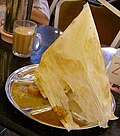
|
Malaysia | Also known as roti tisu or tissue prats, one of the more-creative-looking Malaysian Mamak foods. It is also known as roti helikopter (helicopter bread). Roti tissue is a thinner version of the traditional roti canai, as thin as a piece of 40–50 cm round-shaped tissue. The finishing touches to the making of roti tissue require skill, and they depend on the creativity of the maker. Pictured: Roti tissue, and a glass of Teh tarik |
| Roze koek | 
|
Netherlands | Roze koek ("pink cake") is a typical Dutch pastry that consists of a small flat cake with a layer of pink fondant. The most well-known brand is Glacé. |
| Rugelach | 
|
Ashkenazi )
|
A Cornulete.[citation needed] Traditional rugelach are made in the form of a crescent by rolling a triangle of dough around a filling.[82][83] Some sources state that the rugelach and the French croissant share a common Viennese ancestor, crescent-shaped pastries commemorating the lifting of the Turkish siege in 1793[84] (this could be a reference to the Battle of Vienna in 1683). This appears to be an urban legend however, as both the rugelach and its supposed ancestor (the Kipfel or Kipferl) pre-date the Early Modern era, and the croissant in its modern form did not originate earlier than the 19th century (see viennoiserie ).
|
Runeberg's torte
|

|
Finland | A Finnish pastry flavored with almonds and rum or arrack and usually weighing about 100 grams. There is usually raspberry jam in a sugar ring on the torte. The torte got its name from the Finnish poet Johan Ludvig Runeberg (1804–1877) who, according to legend, enjoyed the torte with punsch for every breakfast. |
| Rustico | 
|
Salento, Italy | Made with puff pastry and a stuffing that varies style by style |
| Sacher Torte | 
|
Austria | A chocolate cake consisting of a dense chocolate cake with a layer of apricot jam in between two halves, coated in dark chocolate icing on the top and sides |
| Samosa | 
|
Indian subcontinent | A fried or baked pastry with a savory filling such as spiced . |
| Schaumrolle | 
|
Austria | Cone or tube of pastry, often filled with whipped cream |
| Schnecken | 
|
Germany | Schnecken were a traditional Saturday morning treat in German homes at the beginning of the 20th century, and was also commonly found in the Jewish immigrant communities in the Philadelphia and Baltimore areas of the United States. The name schnecken means "snails" in English, and refers to the shape of the pastry. Schnecken are commonly confused with rugelach, another German pastry that is different in two respects: (1) schnecken dough is made with sour cream, while rugelach is made with cream cheese; and (2) schnecken are rolled and sliced, whereas rugelach are formed from individual triangles of dough. |
Schneeball
|

|
Germany | Made from plum schnaps . To give it the characteristic shape the dough is rolled out and cut with a dough cutter into even strips. The strips are then arranged alternately over and under a stick, or the handle of a wooden spoon. Eventually the stick is lifted and slowly removed while the dough stripes are formed into a loose ball. Using a special holder called a Schneeballeneisen in order to retain the shape, the ball is deep-fried in boiling fat until golden brown, and finally dusted with confectioner's sugar while still warm.
|
| Schuxen | 
|
Germany | A popular pastry in krapfen with the difference that it is not sweet. Nowadays they are rare, and few bakers produce them.[citation needed ]
|
| Semla | 
|
Sweden | The oldest version of the semla was a plain bread bun, eaten in a bowl of warm milk. In Swedish this is known as hetvägg, from Middle Low German hete Weggen (hot
Today, the Swedish-Finnish semla[89] consists of a cardamom-spiced wheat bun which has its top cut off and insides scooped out, and is then filled with a mix of the scooped-out bread crumbs, milk and almond paste, topped with whipped cream. The cut-off top serves as a lid and is dusted with powdered sugar. Some people still eat it in a bowl of hot milk. |
| Sfenj | 
|
North Africa | A Moroccan, Algerian and Tunisian doughnut, cooked in oil. Sfenjs are eaten sprinkled with sugar or soaked in honey. Sfenj is an Arabic word ("isfenj") which means "sponge". |
| Sfințișori | 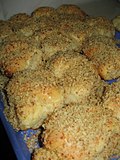
|
Romania, Moldova | Traditional pastries to commemorate the Christian feast of the Forty Martyrs of Sebaste. Sfințișori dough is baked in large shapes of the figure 8, then soaked in honey syrup with ground walnuts. |
Sfogliatelle
|

|
Italy | Sfogliatelle are shell shaped filled pastries native to Italian cuisine. "Sfogliatelle" means "many leaves/layers", the pastry's texture resembling leaves stacked on each other. Filling recipes also vary; some examples are an orange-flavored ricotta filling, almond paste or candied peel of citron. Italian-American bakeries, especially in the New York City area, created a cousin pastry to the sfogliatelle in the 1900s called a "lobster tail" or "egg plant" version. The pastry has the same outside as sfogliatelle, but instead of the ricotta filling, there is a French cream, similar to whipped cream inside. |
| Shortcrust pastry | 
|
Europe | Often used for the base of a tart, quiche or pie. It does not puff up during baking because it usually contains no leavening agent. It is possible to make shortcrust pastry with self-raising flour, however. Shortcrust pastry can be used to make both sweet and savory pies. |
| Sou | 
|
China | Dried flaky Chinatowns. In Shanghai cuisine, a number of dried varieties are available, such as peanut sou (花生酥), green bean sou (綠豆酥) or walnut sou (核桃酥). People often buy them for souvenirs in boxed forms.
|
Savory spinach pie
|

|
Balkans | A savory spinach pie is in the burek ).
|
| Steak and kidney pie | 
|
Britain | A savoury pie filled principally with a mixture of diced beef, diced kidney (which may be beef, lamb, veal, or pork) and onion. Its contents are generally similar to those of steak and kidney puddings. |
| Strudel | 
|
Central Europe | Layered pastry, typically with a sweet filling inside. Often served with cream. Strudel became well known and gained popularity in the 18th century through the Habsburg Empire. Pictured is a pecan strudel. See also – Apple strudel; Milk-cream strudel |
| Stutenkerl | 
|
Germany | Part of the Protestant Reformation , to make the originally Catholic bishop figure more secular.
|
| Sufganiyah | 
|
Israel | A ball-shaped doughnut that is first deep-fried, then pierced and injected with jelly or custard, and then topped with powdered sugar. Widely consumed in Israel in the weeks leading up to and including the Hanukkah holiday.[91]
The same type of deep-fried bun is a traditional pastry in German speaking countries and has diverse names . There, it is traditionally consumed on New Year's Eve and the carnival holidays. In Denmark they are well known as Berliner van kuchen or just Berliner.
|
| Suncake | 
|
Taiwan | A Taiwanese dessert originally from the city of Taichung, in central Taiwan. The typical fillings consist of maltose (condensed malt sugar), and they are usually sold in special gift boxes as souvenirs for visitors. Some famous suncake pastry shops always have long lines of people waiting to buy boxed suncakes. Suncakes are round, and they may vary in size. They are characterized by flaky crusts. Most people eat them with tea, and some people dissolve them in hot water to make a porridge-like dessert. |
| Taiyaki | 
|
Japan | A Japanese pastry shaped to resemble a bungeoppang .
|
| Taro pastry | 
|
Taiwan | A Taiwanese shortbread snack with a spherical shape and made with taro as sweet filling |
| Toaster pastry | 
|
United States | Designed to be safely heated in a toaster, toaster pastries are a convenience food. Most toaster pastries have a fruit filling, but some contain dessert-like fillings such as chocolate or cinnamon. The Pop-Tarts brand of toaster pastries is an example of a mass-produced product widely available in the United States. |
Torpil
|

|
Turkey (Balkans) | Typically torpedo or cone-shaped, stuffed with cream, dispersed to the Balkans during the Ottoman period. Also known as külah. |
Tortell
|

|
Spain(Catalonia) | Typically O-shaped, stuffed with marzipan, and on some special occasions is topped with glazed fruit. It is traditionally eaten on January 6 (Epiphany), at the conclusion of the Twelve Days of Christmas. |
| Tortita negra | 
|
Spain | Translated in English as "little black pastry", a Spanish dessert which is flat at its base and round on the sides. They are eaten in Argentina, Colombia and Venezuela, and are a popular food at children's parties.[92] |
| Trdelník | 
|
Slovakia | A traditional cake and sweet pastry, known from Slovakia. There is similar variant of the Trdelník in the Czech Republic and Hungary (under a different name), originally coming from Skalica in Slovakia. It is made from rolled dough, wrapped around a stick, then grilled and topped with sugar and walnut mix. |
| Turnover | 
|
Made by placing a filling on a piece of dough, folding the dough over, and sealing it. Turnovers can be sweet or savory and are often made as a sort of portable meal or dessert, similar to a sandwich. Pictured is a sweet turnover made from puff pastry. | |
Utap
|
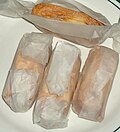
|
Philippines | An oval-shaped puff pastry, especially common in Cebu, where it originated. It usually consists of a combination of flour, shortening, coconut, and sugar. In order to achieve the texture of the pastry, it must undergo a two-stage baking process. |
| Vatrushka | 
|
Eastern Europe | Ring of dough and cottage cheese in the middle, often with raisins or bits of fruit |
| Vetkoek | 
|
South Africa | A traditional , or jam. |
| Viennoiserie | 
|
France | Viennoiserie (French etymological sense: 'things of Vienna') are apple turnover .
|
| Vol-au-vent | 
|
France (Paris) | French for "windblown" to describe its lightness, it is a small hollow case of Rue de la Paix, France, in 1803–04.[93] But the pastry is mentioned at least as far back as 1797;[94] its origin then is obscure. Vols-au-vent are typically made by cutting two circles in rolled-out puff pastry, cutting a hole in one of them, then stacking the ring-shaped piece on top of the disc-shaped piece.[95]
|
| Xuixo | 
|
Spain (Catalonia) | A cylindrical pastry filled with crema catalana that is deep fried and covered with crystallized sugar. |
| Yurla | Tibet | Wheat pastry with butter, particularly common in Nyainrong County in northern Tibet.[64] | |
| Zeeuwse bolus | 
|
Sephardic ))
|
Sweet pastry from the Dutch province of Zeeland, made by baking a type of dough in a spiral shape and then covered with treacle and cinnamon. |
Zlabia
|

|
Southwest Asia, Northeast Africa | A version of the South Asian jalebi (qv) found in areas of north and northwest Africa such as Morocco, Algeria, Tunisia, and Libya. Natural ingredients include flour, yeast, yoghurt, and sugar. This is then mixed with water and cardamom. |
Unsorted
- Apfelküchle
- Carolina
- Chebakia
- Coventry Godcakes
- Ghunzakhi
- Gukhwappang
- Leningradsky cake
- Osmanthus cake
- Shorgoghal
See also
References
- ISBN 9781844805310
- ^ Worldmark Encyclopedia of Cultures and Daily Life: Europe, 2009,
A popular sweet pastry is Alexander Torte, which is filled with raspberries or cranberries.
- ^ Fodor's Russia, the Republics and the Baltics, 1991,
In Latvia: ... Alexander Torte (raspberry-filled pastry strips).
- ^ Felicity Cloake (17 March 2011), "How to cook the perfect apple strudel", The Guardian, archived from the original on 18 April 2017, retrieved 15 December 2016
- ISBN 978-981-232-546-4. Archivedfrom the original on 2023-07-15. Retrieved 2019-02-01.
- ^ "Kuih Bahulu – Resepi Kuih Bahulu Cermai" (in Malay). Resepi Kuih Tradisional. Archived from the original on 2 February 2014. Retrieved 19 August 2013.
- ^ "12 Snacks We All End up Eating During Chinese New Year No Matter How You Resist". RojakDaily. Archived from the original on 27 October 2022. Retrieved 1 February 2019.
- ISBN 978-1-55285-646-8.
- ^ "Азербайджанская пахлава". 2009-03-24. Archived from the original on 2020-01-25. Retrieved 2012-05-05.
- ISBN 0-313-32733-5.
- ISBN 0-882-89304-1.
- ^ "The Forfar Bridie". Jas McLaren & Son. Archived from the original on 26 April 2012. Retrieved 21 March 2012.
- ^ Eliana Thibaut i Comalada, Les Coques Catalanes, Proa, Barcelona 1995.
- ^ "Coca de recapte". Archived from the original on 2023-04-05. Retrieved 2012-05-06.
- ^ "Coca d'albercoc". Archived from the original on 2023-04-05. Retrieved 2012-05-06.
- ^ Coca massegada Archived 2011-07-20 at the Wayback Machine (in Spanish)
- ISBN 0-231-06989-8.
- ^ "Tarte conversation, recette, trucs astuces et explications". La cuisine de Mercotte (in French). 28 November 2012. Archived from the original on 7 February 2016. Retrieved 6 February 2016.
- ^ Good Housekeeping Institute, ed. (1966). Good Housekeeping's Cookery Book. Principal: Carol Macartney. London: The Hearst Corporation. p. 327.
- ^ "Jacob Grimm and Wilhelm Grimm, Deutsches Wörterbuch von Jacob Grimm und Wilhelm Grimm 11". Archived from the original on 2015-10-01. Retrieved 2012-05-06.
- ^ The 1839 date, and most of what follows, is documented in Jim Chevallier, "August Zang and the French Croissant: How Viennoiserie Came to France", p. 3-30; for the 1838 date, see Giles MacDonogh "Reflections on the Third Meditation of La Physiologie du goût and Slow Food" Archived 2016-03-03 at the Wayback Machine (p. 8); an Austrian PowerPoint – Ess-Stile Archived 2011-07-06 at the Wayback Machine – gives the date of 1840 (slide 46). A 1909 image of the bakery shows the same date for its founding, but the bakery was already documented in the press before that.
- ^ Tacey Rosolowski, "Dessert time" Archived 2011-07-20 at the Wayback Machine
- ^ "Croquembouche Delicious Magazine". Archived from the original on 2014-07-07. Retrieved 2012-05-15.
- ^ "Curry Puff recipe on MalaysianFood.net". Archived from the original on 2012-05-10. Retrieved 2012-05-15.
- ^ "Djevrek recipe (in Serbian)". Archived from the original on 2012-02-17. Retrieved 2012-05-07.
- ^ ISBN 978-0-517-57032-6.
- ^ "Historia de la empanada criolla" (PDF). Dra. Susana Barberis. Archived (PDF) from the original on 22 September 2020. Retrieved 8 July 2010.
- ^ Penelope Casas (1982), The Foods and Wines of Spain, Alfred A. Knopf, New York 1982 (p. 52)
- ^ "Breve historia de la alimentación en Argentina". Liliana Agrasar. Archived from the original on 17 September 2019. Retrieved 8 July 2010.
- ISBN 0-313-32147-7.
- ^ Lady Brighid ni Chiarain. "An English translation of Ruperto de Nola's "Libre del Coch"". Stefan's Florilegium. Archived from the original on April 7, 2019. Retrieved January 31, 2011.
- ^ Clifford A. Wright (1999), A Mediterranean Feast, William Morrow, New York (p. 573)
- ^ Flaó and Greixonera Archived 2011-09-19 at the Wayback Machine
- ISBN 978-0-471-34646-3.
- ISBN 978-7-5085-0254-0. Retrieved 5 August 2011.
- ^ "What is Hamantashen?". Archived from the original on 2013-04-04. Retrieved 2012-05-07.
- ^ "Epi Log: The latest in Food News, the Culinary Arts & Cooking". Archived from the original on 2012-06-30. Retrieved 2012-05-07.
- ^ "Sealing (definition)". The Huffington Post (Food encyclopedia). Archived from the original on April 29, 2012. Retrieved May 7, 2012.
- ^ Prince, Rose (3 September 2009). "Aldeburgh Food & Drink Festival: leg of lamb baked in hay and a huff paste recipe". The Daily Telegraph. London. Archived from the original on 6 February 2017. Retrieved 5 April 2018.
- ^ "Outlet types and regions: Good Food Near You: Good Food Channel". Uktv.co.uk. Archived from the original on 2019-09-09. Retrieved 2012-05-07.
- ^ About kosher food
- ^ Devery, Caitriona (2020-10-27). "Mysteries of the Deli: The Jambon". District Magazine. Retrieved 2021-04-07.
- ISBN 978-1-118-06066-7.
- ISBN 963-05-1287-4. Archivedfrom the original on 2021-01-09. Retrieved 2008-10-04.
- Oxford Companion to Food
- ^ "Houston Press – Kolache Crawl: Klobasneks". Archived from the original on 2012-09-27. Retrieved 2012-05-08.
- ^ "Memphis Flyer – Kolaches at Donald's Donuts". Archived from the original on 2016-04-20. Retrieved 2012-05-08.
- ^ Koenig, Josie, and John Ward, trans. Domaci Kucharstvi: The Art of Home Cooking. Schulenburg, TX: Sts. Cyril and Methodius Catholic Church Board, 1997. Print.
- ^ Wasserman, Tina. "Cooking: The Ultimate Jewish Finger Food". Reform Judaism Magazine. Archived from the original on December 22, 2010. Retrieved 2010-09-14.
- ^ "Czech, Please: 2000s Archive : gourmet.com". Prod.gourmet.com. 2011-08-01. Archived from the original on 2012-03-17. Retrieved 2012-02-20.
- ^ "Kolompeh, a flaky and sweet date filled pastry from Kerman – Persian / Iranian Pastries – Pinterest". Pinterest. 26 August 2013. Archived from the original on 12 January 2023. Retrieved 12 July 2015.
- ISBN 9780517169636.
- ISBN 9781860640117
- ISBN 978-0-595-34503-8.
- ISBN 1740452542
- ^ Irene Krauß, Chronik bildschöner Backwerke, Stuttgart 1999, S. 261 f.
- ^ June Meyers Authentic Hungarian Heirloon Recipes Cookbook
- ^ Iaia, Sarah Kelly. Festive Baking: Holiday Classics in the Swiss, German, and Austrian Traditions. Doubleday, 1988.
- ISBN 0961875941
- ^ Rachel Tan (24 March 2015). "Traditional biscuits to be featured in new stamp series". The Straits Times. Archived from the original on 4 September 2017. Retrieved 4 July 2017.
- ^ Rahimy Rahim (8 June 2017). "Traditional kuih makmur gets a makeover". The Star. Archived from the original on 9 July 2017. Retrieved 4 July 2017.
- ^ Makroudh – La Cuisinede Ma Copine Archived 2012-07-08 at the Wayback Machine
- ^ The great book of couscous: classic cuisines of Morocco, Algeria, and Tunisia – Page 230
- ^ ISBN 978-7-5085-0254-0. Retrieved 5 August 2011.
- ISBN 978-1-60774-236-4.
- ^ "o713286.htm;internal&action=_setlanguage.action?LANGUAGE=en AEIOU Encyclopedia". Archived from the original on 2012-05-21. Retrieved 2012-05-09.
- ISBN 978-0-696-22732-5.
- ^ Club, Houston Civic; Crawford, Mrs. C.M. (1906). Houston Civic Club Cook Book. p. 85.
- ^ Virginia Cookery-book. Harper. 1912. p. 18.
- ^ Mollois, Emmanuel. Et Voila. Fremantle Press
- ^ "#1 Pastizzi.com". Pastizzi. Archived from the original on 2022-05-26. Retrieved 2010-01-21.
- ISBN 978-1-86011-365-9.
- ^ a b "Pastry Hearts Fill Us With Joy and Suspicious Sugar Paste". Buffalo Chow.com. January 1, 2008. Archived from the original on 3 September 2009. Retrieved 12 October 2009.
- ^ Nyhuis, Philip (Summer 1999). "Balistreri's: Making Bread the old fashioned way". Archives Summer 1999. Buffalo Spree Magazine. Archived from the original on 7 September 2008. Retrieved 13 October 2009.
- ^ "Palmier". Food Dictionary. Epicurious. Archived from the original on 11 August 2010. Retrieved 13 October 2009.
- ISBN 1-86064-603-4.
- ISBN 978-0-313-32773-5.
- ^ "Definition of plăcintă" (in Romanian). DEX on line. Archived from the original on 2014-07-14. Retrieved 2012-05-06.
- ^ PDF of Slovenian cuisine Archived 2009-02-10 at the Wayback Machine (about half way in the article)
- ^ Ramazani, N.; de Planhol, X. "BĀDĀM". Encyclopædia Iranica. Retrieved 7 October 2011.
- ^ New York Media, LLC (1988). New York Magazine. New York Media, LLC. p. 73.
- ISBN 978-0-307-77785-0.
- ISBN 978-1-55832-191-5. Archivedfrom the original on 2023-07-15. Retrieved 2016-09-24.
- ISBN 978-0-684-83559-4. Archivedfrom the original on 2023-07-15. Retrieved 2016-09-24.
- ISBN 978-0-313-37462-3. Archivedfrom the original on 15 July 2023. Retrieved 22 April 2012.
- ^ Swedish semla: more than just a bun Archived 2011-06-06 at the Wayback Machine
- ^ "Nordiska Museét: Fettisdagsbullen". Archived from the original on 2008-06-26. Retrieved 2020-03-11.
- ^ "The special treat FASTLAGSBULLE". Archived from the original on 2008-02-25. Retrieved 2012-05-10.
- ^ "Semla recipes". Archived from the original on 2011-10-02. Retrieved 2012-05-10.
- ISBN 978-1-56426-501-2.
- ^ Roden, Claudia (1996). The Book of Jewish Food: An Odyssey from Samarkand to New York. New York: Alfred A. Knopf.
- ISBN 9780781810258.
- ISBN 978-0-8027-1932-4.
- ^ Semaines critiques, ou Gestes de l'an cinq, Volume 1. l'Imprimerie des Semaines Critiques. 1797. Archived from the original on 2023-07-15. Retrieved 2020-10-19.
- ^ "Vol-au-vent". CooksInfo.com. Archived from the original on 27 September 2014. Retrieved 13 June 2014.
External links
- Pastry – entry at Encyclopædia Britannica
- Pastry Dough – Types at Crafty Baking
